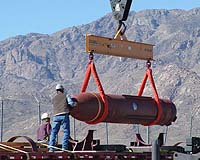| . |  |
. |
Kuala Lumpur, Malaysia (UPI) Aug 18, 2009 An experimental STOL jet aircraft with possible military use has crashed during a test flight in Malaysia, killing its British pilot and inventor. Malaysian civil aviation authorities are investigating the accident of the twin-engine raised-wing Jetpod built by London-based Avcen in which company director Michael Robert Dacre, 53, died. The accident happened Sunday shortly after takeoff from Tekah airstrip near the city of Taiping, around 190 miles north of the Malaysian capital Kuala Lumpur. The incident was witnessed by many residents, according to a report in the English-language newspaper The Star. One witness was only 150 feet from the crash. "Earlier I saw it going down the runway three times but it could not take off. However, on the fourth run, the jet took off into the air but at about 200 meters high, it shot vertically to the sky before veering to its left and then falling to the ground," he said. Firemen were quickly at the scene and said Dacre likely died upon impact, local media reported. The aircraft had been transported in parts in a container to the airstrip about a week ago before being assembled for the test flight, the report said. The single-pilot Jetpod was designed by Dacre, who set up Avcen in the United Kingdom in 1998 to produce the aircraft. Few design details are available. The two over-wing turbofan engines were said to have a thrust of 2 X 13.3kn, and the plane had an operating payload of around 1,540 pounds. Its range was to be just more than 900 miles. The Jetpod was initially marketed as a flying taxi because it needed only 410 feet to take off and land and had a maximum speed of 350 miles per hour. According to Avcen, the Jetpod is ideal as an executive jet for ferrying up to eight people short distances in a hurry. It was designed to make up to 50 five- to 10-minute flights a day, and runways could be built very close to city centers. It is extremely quiet and "hardly discernible," according to Avcen, and is barely more audible that normal city traffic. But military analysts said its real value would come as a small troop carrier or medical station for use during extreme emergency situations in urban areas. It has a rear dropdown ramp like a Hercules C-130 and could move troops around quietly to maintain a surprise element. An Avcen promotional video said it would operate from aircraft carriers without the need for a catapult of arrester gear. Full-scale factory production was scheduled for 2011. Avcen said it was not accepting deposit checks for future aircraft and would sell only what it could produce off the production line. A statement in 2004 seeking investors said that two Unmanned Aerial Vehicle variants were being considered. "The U-500 is capable of rescuing one person remotely under the control of base-station operatives some 300 miles away," the statement said. "Rescuing a person remotely in this way has never been done before. The U-600 has been designed to carry out autonomous light resupply, construction and engineering repair tasking along-side oil rigs, large ships, high-rise buildings and other very remote scientific stations, e.g. Arctic." The death of its creator means the future of the plane could be in doubt, analysts have said, and the company's proposed production date of 2011 is now highly unlikely. Share This Article With Planet Earth
Related Links The latest in Military Technology for the 21st century at SpaceWar.com
 U.S. fast-tracks new bunker-buster bomb
U.S. fast-tracks new bunker-buster bombWashington (UPI) Aug 17, 2009 Amid continuing tension over political upheaval in Iran, the U.S. Defense Department says it wants to accelerate production of a 30,000-pound "ultra-large bunker-buster" bomb designed to destroy deeply buried installations. The Pentagon has requested Congress to provide the necessary funding to ensure that the Massive Ordnance Penetrator, a next-generation bomb known as MOP and built by ... read more |
|
| The content herein, unless otherwise known to be public domain, are Copyright 1995-2009 - SpaceDaily. AFP and UPI Wire Stories are copyright Agence France-Presse and United Press International. ESA Portal Reports are copyright European Space Agency. All NASA sourced material is public domain. Additional copyrights may apply in whole or part to other bona fide parties. Advertising does not imply endorsement,agreement or approval of any opinions, statements or information provided by SpaceDaily on any Web page published or hosted by SpaceDaily. Privacy Statement |